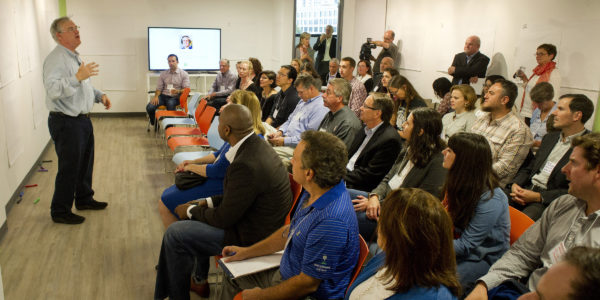
BY RICHARD LEE
Hearst Connecticut Media
Harnessing a multigenerational workforce to produce results while not pulling too hard on the reins can be a challenge, but more than 50 participants in a session hosted by the Cultural Alliance of Fairfield County learned that with some imagination and creativity, age differences can result in a winning combination.
Held at Comradity, a co-working space for creative professionals on Canal Street in Stamford, and facilitated by Brian Mattimore, president of Norwalk-based Growth Engine, which calls itself an innovation agency, the event was a rapid-fire session that teamed participants from a variety of businesses and nonprofit organizations to determine how to turn the differences in a mixed-age workforce into positive interaction and not clashes of cultures.
“When a company turns it around, it can empower a multigenerational workplace,” said John Grace, president and CEO of BrandTaxi, a Stamford-based branding company.
As the head of a business whose employees run the gamut from young college graduates to veterans of the branding industry, Grace has the job of encouraging his staff to work together for the benefit of their clients.
“It’s hard to teach people that it’s OK to share,” said Grace, declining to disclose his age ”“ only to say with a wry smile, “I’m in the older group. I’m often defined as a ”˜dean of the industry.”™”
He said he got some good ideas from his experience at the event.
“One was ”˜teaching up’ ”“ for young people to teach older people. It could be technology. People were into it. I thought it was great,” he said, adding that at later sessions participants will be asked if they implemented any ideas that came out of the session and if they worked.
”˜Different expectations”™
A participant in a subsequent panel discussion Oct. 20 will be Christopher Bruhl, president and CEO of The Business Council of Fairfield County, who said the intergenerational workplace has been an oft-repeated topic at the council’s Human Capital Council meetings.


“At different stages of their lives, employees have different expectations,” Bruhl said. “Authority and management tend to lead to older people managing younger workers, but in some cases, it’s younger people supervising older employees due to their technology skills. Or younger people might have started a business and hired people who are older. Older generations should appreciate younger employees as performers and not just learners, and younger people should appreciate older workers because their experience has value.”
A key is to find things that both groups have in common, he said.
Richard Rapp, president of Altamira, a Westport consultancy focusing on advertising, branding and communications, said Mattimore succeeded in drawing creative responses from everyone in the group.
“There was one consistent theme ”“ people want to have a voice and do meaningful work and work collaboratively. That seems to run across all ages,” said Rapp, 58, who is bringing some of those ideas back to his five-person business. “I’m going to listen more instead of projecting my ideas. It’s about ideas, but they don’t just happen. They’re nurtured.”
Creative economy
Mattimore has many years of experience in conducting events like the one at Comradity, honing his technique to encourage even the most inhibited participant to get involved.
“We’ve done over 1,000 ”˜ideation sessions.”™ We trigger our clients right away,” he said, dividing the group up into small teams and encouraging them to write their ideas about how to create a better work environment on sheets of paper taped to the walls around a large room. “There could be 50, 60, 70 or 80 ideas. We’ll funnel them down to 12 to 15 that can be developed.”
The Cultural Alliance of Fairfield County is hosting the “Creativity in the Workplace” sessions as a way to demonstrate its role as a partner in the creative economy, according to David Green, program director of the alliance.
“We’re interested in promoting activity between arts and cultural groups and businesses and fostering greater creativity in the 21st century workplace,” he said.
Comradity, a workspace where business, creative professionals and educators collaborate to share ideas, was the ideal place to conduct the ideation session, said Jim Kern, co-founder of the business with his wife, Katherine Kern.
It has 26 resident members and a co-working space in an open studio where individual and mobile network members work together on projects.
“Businesses and creativity often tend to be silos. We like to get business leaders, students, creative types and the academic world together,” Jim Kern said, adding that managers in their 50s must determine how they can get the best out of new employees right out of college. The result can be companies suffering because they cannot attract young, creative people, he said.
“How do I take advantage of a young employee without stomping out their desire to get ahead?” he said. “Young employees can feel stifled.”
Hearst Connecticut Media includes four daily newspapers: Connecticut Post, Greenwich Time, The Advocate (Stamford) and The News Times (Danbury). See stamfordadvocate.com for more from this reporter.



















